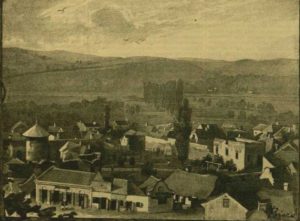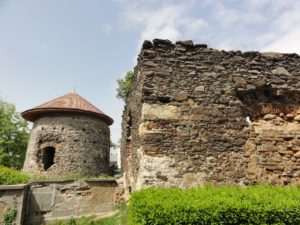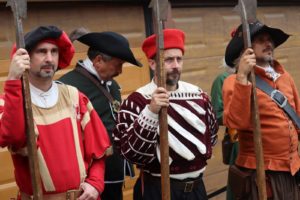Szilágysomlyó
Szilágysomlyó (Șimleu Silvaniei, Schomlenmarkt) is famous for the Báthory Castle or Báthory Citadel, it can be found in Transylvania, Romania. As the former Somlyó Castle stands on the hill above the town, the Báthory Castle is also known as the Lower Castle.

The oldest castle on the top of Magura Hill, at an altitude of 500 meters, dates back to the time of the conquest of Magyar tribes and is known as the “pagan castle”. It was a castle fortified with a palisade wall, but today practically nothing remained. However, archaeological excavations have confirmed its exact location and site. According to a legend: ‘There is a clearing up on the hill, called Vulture, where our conquering ancestors threw the food scraps from behind the palisades, and this is where the vultures of the area fed’.

It was first mentioned in 1251 as Vathasomlyova. The settlement was the ancestral estate of the Csolt clan, descended from the rebellious Vata. In 1258, Watha son of Watha of the clan Csolt, and Povsa son of Dénes sold Vatasomlaja together with its manor to Roland of the Rátót Clan and Móric of the Pók Clan for 120 marks and had its boundaries demarcated.

In 1319, Voivode Miklós, the son of Móric of Miklós from the Pók Clan gave the village of Szécs, which belonged to the Somlyó estate, to the sons of Luka. The castle was built by the Transylvanian Voivode Miklós in the early 14th century and was first mentioned in 1319.

In 1341 it was demarcated from the Valka manor. At that time, it was the estate of Voivode Móric’s son (Meggyesi) Simon and István son of István. The first mention of the castle of Szilágysomlyó (Somlyó) was in 1351 when it and its manor were given to Anna, daughter of Móric Meggyesi, by Báthory Lászlóné, as a daughter’s quarter. (Note, that after the 14th century, I use the Oriental name order for Hungarians where family names came first.)

The ancestral seat of the Báthori family (since 1351), their ancient castle, Somlyóvár, stood on Magura Hill. However, it was abandoned when the castle was built in the town and the old castle on the summit has been ruined ever since.

On 27 September 1533, one of the greatest Transylvanian princes, Báthory István, king of Poland from 1575 to 1586, was born in Szilágysomlyó. With his army of mainly Hajdú soldiers and Székelys and Polish mercenaries, but also of other peoples, he defeated the Russian Tsar’s army in three campaigns, regained Livonia for Poland, and conquered Lithuanian Belorussia, etc.

In the meantime, he had also governed Transylvania well, and the Turks and Habsburgs were kept quiet, for he had a serious military force. He had planned to form an alliance of Poland, Upper Hungary, and Transylvania, by which he could have displaced both the Turks and the Habsburgs, but he died unexpectedly in 1586 at Grodno in Lithuania. You can read more about him here: https://www.hungarianottomanwars.com/essays/bathory-istvan-king-of-poland-and-prince-of-transylvania-1533-1586/
The first written record of the local school dates back to 1554, we know that around 1680 Királyhelmeczi János was the rector of the Somlyó school. After Somlyó castle was occupied and destroyed by the Turks in 1551, Báthory István had a castle built in 1592 in Szilágysomlyó. In 1594, when Prince Báthory Zsigmond executed István’s brother Báthory Boldizsár, István fled to Poland and the castle passed into the hands of the prince. At that time, a detailed inventory was drawn up, listing all the buildings and movables belonging to the castle.

During the reign of Prince Báthory András, the castle was again in the possession of István, but in 1599 Giorgio Basta occupied the castle, even though the prince’s troops were also involved in its defense. In 1602 it was again a princely estate, and in 1612 it was donated by Báthory Gábor to his half-brother András. Before András’s daughter Zsófia became the wife of Prince Rákóczi II György in 1643, the castle was the site of an ornate marriage ceremony. Construction continued in the castle in the 17th century; in 1649, stove tiles were brought from the Habán craftsmen in Alvinc, and in 1656, brick layers from Kolozsvár were contracted.

After the death of András Báthory András’ widow, Zakreszka Anna (1658), the castle passed to her grandson, Prince Rákóczi I Ferenc. In 1660, the town and the castle were destroyed by Turkish-Tatar troops, who were sent as punishment for the campaigns of Rákóczi II György in Poland.

In 1670, Báthory Zsófia pledged the estate and the castle to Bánffy Dénes and his wife, Bornemisza Kata, but at the same time, the Transylvanian Diet of 15 February 1670 gave them to Gyerőffy György because of his claim for compensation against Rákóczi György, so long litigation began. Bánffy Dénes was executed in 1674, and in 1677 the Somlyó castle and manor became the property of Bánffy’s widow, Mrs. Bornemisza Kata. During this period, after Várad (Oradea) fell to the Turks (1660), the castle functioned as a fortress and was inhabited by the prince’s mercenaries.

In 1687, Duke Charles of Lothar occupied the castle; it was probably Luigi Ferdinando Marsigli, the military engineer who accompanied him, who drew the first surviving plans of the castle. After the recapture of Várad (1692), the Báthory Castle of Szilágysomlyó became militarily insignificant. In 1703, the castle was occupied by the Kuruc troops of Prince Rákóczi II Ferenc, but the census of 1703-4 refers to it as ‘so ruined by enemy fire’. After the Peace of Szatmár in 1711, the castle was used by the military as a food store. The building was in a steady state of disrepair; by the time of the 1851 survey, several buildings were missing.


In 1910, 6030 of its 6885 inhabitants were Hungarian, and 759 were Romanian. In 2011, the population of the nearby area of Szilágysomlyó was 11 653, 7716 Romanians, 3285 Hungarians, and 68 Gypsies.


Now, the castle is the destination of reenactors coming there from many countries to participate in the Báthory Fest. In 2023, the two twin municipalities of Szilágysomlyó, Nyírbátor in Hungary and Czchow in Poland, jointly applied for the festival through the European program. Here is more about this festival:
https://www.facebook.com/bathoryfest/?locale=hu_HU
and also: https://bathoryfest.ro/

Source: partly from Wikipedia and from https://erdelyinaplo.ro/aktualis/riportok/szilagysomlyo-harom-var-egyetlen-romja#
Dear Readers, I can only make this content available through small donations or by selling my books or T-shirts.
If you like my writings, please feel free to support me with a coffee here:
You can check out my books on Amazon or Draft2Digital, they are available in hardcover, paperback, or ebook:
https://www.amazon.com/dp/198020490X or at https://books2read.com/b/boYd81

My work can also be followed and supported on Patreon: Become a Patron!http://Become a Patron!



























